Farming

Poultry pest management is an important element in any production. Learn about these pests and methods to control them.
Mites and lice are the most common external parasites of poultry in Alabama. The major pests include the northern fowl mite, the chicken mite, the bed bug, and several species of biting lice. Mosquitoes and black flies have also caused problems in some areas of Alabama. Fowl ticks, sticktight fleas, scaly-leg mites, depluming mites, and chiggers rarely become serious pests in modern commercial poultry operations.
External parasites can slow the growth, lower the vitality, damage the plumage, and reduce the egg production of poultry. Heavy infestations have been known to reduce egg production by as much as 30 percent. In addition, heavy infestations can make birds susceptible to other parasites and diseases that can cause death.
Pests of Poultry
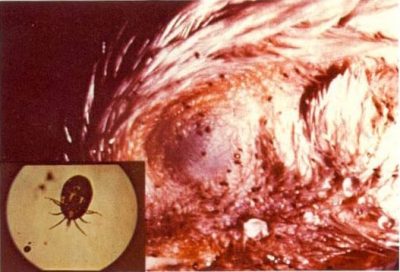
Figure 1. Northern fowl mite infestation. Insert shows individual mite
Northern fowl mite. This is the most damaging external parasite of caged poultry (Figure 1). Birds under stress appear to suffer heavier populations of northern fowl mites than unstressed birds. Stressed and caged poultry show an erratic pattern of infestation, but modern poultry confinement and management have probably intensified the problem with northern fowl mites. Unlike the chicken mite, northern fowl mites stay on the bird most of the time. These mites are brought into poultry houses by wild birds, or they come in on new flocks.
Constant efforts must be made to prevent the northern fowl mite from causing serious economic loss. While infestations vary greatly—even from bird to bird—the overall effect could be a reduction by several percentage points in production efficiency and feed consumption. Heavy infestations on pullets as they begin laying can cause a 10 to 30 percent mortality rate.
The mite’s development from egg to egg-laying adult takes about one week under optimum conditions (cool months are more favorable than warm months). While adult mites do not lay a large number of eggs, populations can increase rapidly on a susceptible bird and may exceed 20,000 mites in only a few weeks. These mites suck blood and spend their entire lives on the bird. If mites are present in a flock, they can easily be detected on the feathers and the skin around the vent. All life stages—from egg to adult—will be present in the feathers, along with their cast skins and excrement. Also, the skin around the vent will be irritated and scabby.
Chicken mite (roost mite, red chicken mite). This mite may be present in poultry operations. However, unlike the northern fowl mite, it does not live on the bird and can be easily controlled in commercial operations by using the proper insecticide. The chicken mite is probably a greater problem in floor nests and on floor-housed birds. During the daytime, the chicken mite lives in secluded areas around poultry houses such as cracks and crevices, roosts, walls, ceilings, and floors. At night, the mite becomes active and crawls onto the bird to take a blood meal. Infestations may go unnoticed unless birds are examined at night. If mites are found on the birds only at night, this indicates that it is the common chicken mite. Chicken mites can also be detected by examining secluded areas around poultry houses. You should look for gray, brown, or red mites. Other signs of chicken mites include black and white deposits of excrement and cast skins.
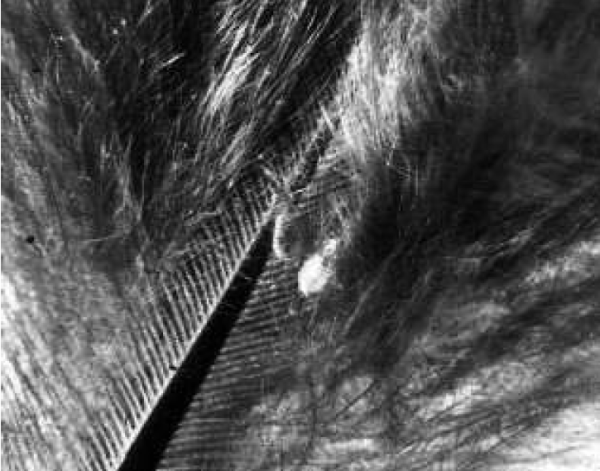
Figure 2. Chicken lice infestation of a feather shaft
Heavy infestations of chicken mites cause birds to have pale combs and wattles. Birds also become droopy and weak, making them more susceptible to other parasites and diseases. The life cycle of the chicken mite is similar to that of the northern fowl mite, with 7 to 14 days required to complete a generation; therefore, heavy infestations build up quickly if not controlled. Because this mite usually hides in cracks and crevices during daylight hours, control measures can be directed only at the building.
Biting lice. More than 40 species of chewing lice can attack domestic fowl. However, chewing lice are found only occasionally in modern commercial poultry operations. Biting lice can be a problem on floor-housed poultry, but they are seldom a problem on caged poultry. Biting lice are wingless, six-legged insects with flattened bodies and broad, rounded heads. Common species include head lice, body lice, shaft lice, wing lice, fluff lice, large chicken lice, and brown chicken lice (Figure 2). All are biting or chewing lice but none suck blood. They irritate birds by constantly chewing at their skin and at the base of their feathers. This constant irritation results in birds that are stressed.
These mites seldom leave the body of an infested bird except when moving to another bird. A female louse may lay as many as 60 eggs. A typical life cycle requires about 30 days from egg to adult. Females lay eggs on the bird, cementing them to the feathers. In heavy infestations, large, dense clusters of eggs are present.
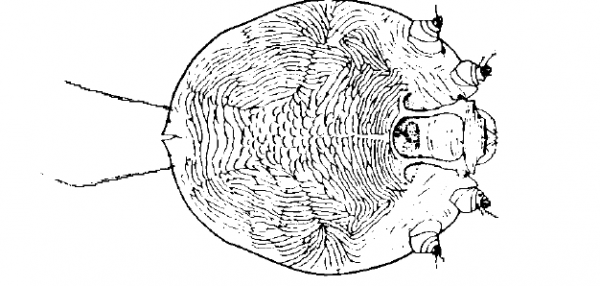
Figure 3. Dorsal view of scaly-leg mite
Scaly-leg mite. Sometimes, small farm flocks may become infested with this itch mite, which is almost microscopic in size, measuring from 1⁄100 to 1⁄50 of an inch across (Figure 3). They are pale gray with a nearly circular outline. These mites primarily infest the legs and feet, tunneling in the upper layers of skin where they lay their eggs. Their habits greatly irritate poultry.
Depluming mite. This mite is similar to the scaly-leg mite but is smaller. It burrows into the skin at the base of the feathers, and the irritation causes birds to pull out their feathers.
Fowl tick or bluebug. Fowl ticks are fairly large, about 1⁄4- to 1⁄2-inch long when mature, and are flattened, leathery, eight-legged, blood-sucking, external poultry parasites. Both males and females feed at night and become filled with blood in less than one hour. After feeding, they seek shelter in cracks and crevices, where the female deposits her eggs. The eggs hatch in about two weeks, and the six-legged larvae, or seed ticks, find a host and attach themselves. After about five days of feeding, they drop off, shed their skins, and become eight-legged nymphs. The nymphs feed, moult, and go through two or three more nymphal stages before becoming adults. The entire life cycle requires a minimum of 30 to 40 days if the food and temperature are suitable. Spraying poultry houses with insecticides has almost eliminated this tick from commercial operations.
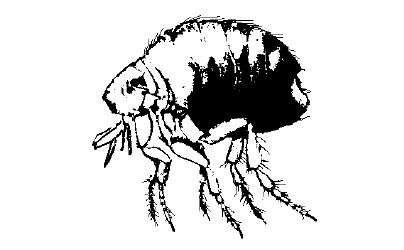
Figure 4. Sticktight flea
Sticktight or southern chicken flea. Black rings around the legs of young birds or black spots on wattles or combs may be clusters of fleas with their heads embedded in the skin (Figure 4). These pests suck blood, causing great irritation and affecting growth and egg production. Young birds may die from heavy infestations.
Mating usually occurs on the bird. Female fleas lay eggs, which drop to the floor or into the litter. Eggs hatch in a few days, and slender white larvae feed on debris in cracks and litter on the floor. Larvae spin cocoons and pupate. Adult fleas then emerge from the pupal cases. Generations are completed in one to two months.
Bed bug. Bed bugs are found in breeder flocks or other floor-housed birds. They hide, breed, and lay their eggs in nests, behind nest boxes, under loose boards, and in cracks around the walls, roosts, and roofs of buildings. At night, young and old bed bugs crawl onto birds and suck blood. Because they are found hiding during the daytime in cracks, around walls, and in equipment, they can best be controlled by treating these areas. When disturbed, bed bugs give off a distinct odor similar to that of stink bugs.
Chigger. Chiggers are usually not pests of poultry unless birds are allowed to range in wooded or brushy areas that are infested (Figure 5). Infested birds have reddish patches of chiggers on the skin. Lesions may form if the infestation is severe.
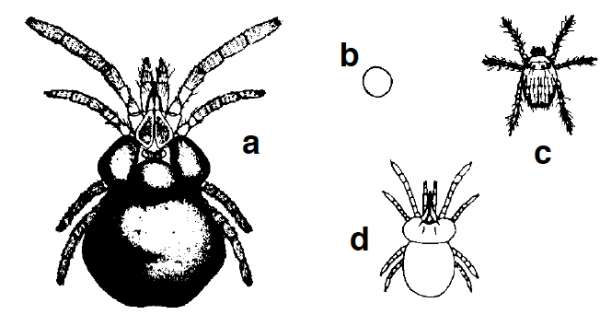
Figure 5. Chiggers: (a) adult, (b) egg, (c) larva, (d) nymph
Turkey gnat (black fly). This is a tiny, bloodsucking gnat or fly that may feed in high numbers on poultry in certain areas of Alabama (Figure 6). They feed on the bird around the head, including the comb, and around the eyes and beak. They breed in running water and are usually a serious problem only for two to three weeks in the early spring. The most effective method of control is direct sprays to the bird using an insecticide that is also a repellent (permethrin).
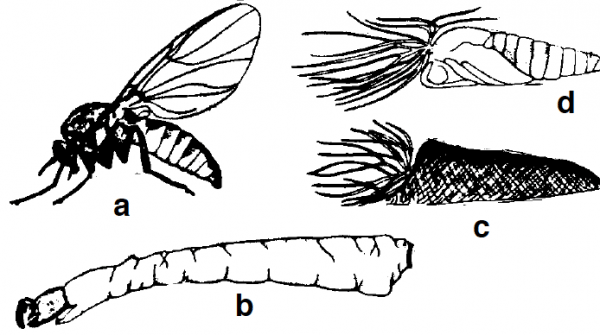
Figure 6. Turkey gnat: (a) adult, (b) larva, (c) cocoon, (d) pupa
Darkling beetle or lesser mealworm. The darkling beetle or lesser mealworm, Alphitobius diaperinus (Panzer), has become a nuisance in ground house operations such as broiler houses (Figure 7). Large populations of beetles sometimes migrate into nearby residence areas, especially during litter clean-out time. Although beetles can fly up to one mile, most crawl at night from disposed litter to neighboring fields and homes. Beetles are frequently associated with poultry feed, preferring grain and cereal products that are damp, moldy, and slightly out of condition. Both adults and larvae consume poultry feed in amounts costly to the producer. Larvae are known as lesser mealworms. Increased importance has been placed on control of this beetle. Both adult beetles and larvae act as reservoirs for many poultry pathogens and parasites
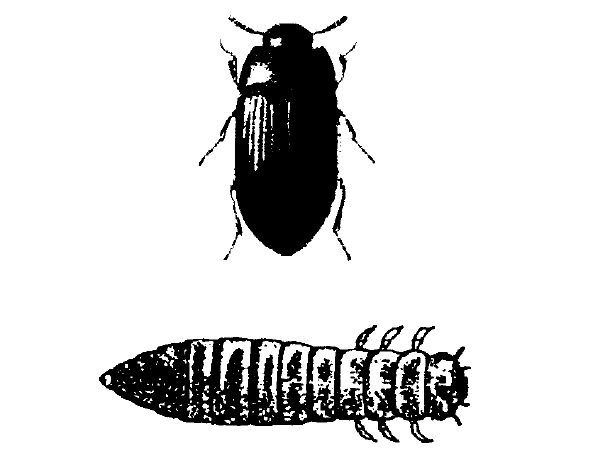
Figure 7. Lesser mealworm or darling beetle adult larva
Scientists have been able to transmit the causative agent of acute leukosis (Marek’s disease) in chickens by using this beetle. Positive confirmation of the transmission has been made under both laboratory and field research conditions.
Marek’s disease usually affects birds between three and four months old. Symptoms are characterized by various degrees of paralysis, most easily observed in legs and wings. Droopy wings, gasping, weight loss, pallor, and diarrhea are also symptoms. Birds severely affected may be found lying on their sides with one leg stretched forward and the other held behind. The disease affects both broiler and egg laying types of poultry. Losses can reach two percent of the flock per day, and mortality may exceed 30 percent of the flock within a few weeks.
Acute leukosis is highly contagious and has been shown to be airborne. Contamination may persist in the environment because the darkling beetle may serve as a reservoir for residual contamination. Beetles have been observed feeding on carcasses of poultry dead of leukosis, and it appears that beetles may become contaminated in the process. Adult beetles are capable of retaining and transmitting the leukosis when eaten by chickens, in the opinion of some scientists. Other diseases that are spread by beetles include the causative agents of avian influenza, salmonella, fowl pox, coccidiosis, botulism, and new castle disease. They also act as vectors of cecal worms and avian tapeworms.
In the poultry house, a beetle can lay up to 800 eggs in litter during a 42-day period. Eggs develop into larvae in four to seven days. The life cycle requires about 42 to 97 days, depending on temperature. Adult beetles live from 3 months to a year. Adults are black or very dark reddish-brown, and about 1⁄4-inch long. Larvae are yellowish-brown (wireworm-like), up to 3⁄4-inch long, and accumulate in dark corners of manure or litter, especially under sacks, in bins, or in places where feed is stored. Pupation occurs in the litter, soil, and side walls of poultry houses.
Adult chickens and chicks are more likely to eat the beetles and their larvae than poults or turkeys. Consumption of beetles and larvae may have a negative effect on feed conversion and rate of gain. Darkling beetle control is difficult, but may be best achieved by spraying wooden portions of side walls at clean-out with an effective insecticide, such as permethrin.
Boric acid, labeled as SafeCide, is also effective for darkling beetle control in broiler and breeder hen houses. Boric acid is applied to the floor of broiler houses between grow-outs; long residual control (9 months to 1 year) is suggested. Cost of control has been a consideration in the past with boric acid.
Controlling External Parasites
The successful control of external parasites on poultry involves several considerations, including the selection of the proper insecticide. Certain chemicals are labeled and recommended for specific external pests of poultry. For insecticides labeled and recommended for the control of pests, see the Georgia Pest Management Handbook at http://extension.uga.edu/programs-services/integrated-pest-management/publications/handbooks.html#commercial.
As stated earlier, the northern fowl mite is the most serious and the most difficult pest to control in modern commercial operations. Successful control of it and other external parasites of poultry involves several important factors, including the following
- Early detection by thorough inspections of new flocks and by periodic checks.
- Prompt treatment of hot spots to prevent populations from spreading throughout the operation.
- Using proper application methods to ensure the effective use of insecticides.
- Follow-up applications at proper intervals when mite or other parasite infestations are heavy.
Control of Flies in and Around Poultry Houses
One of the largest poultry pest management problems facing the poultry producer today is fly control. Large poultry operations have as a byproduct a large volume of waste that cannot be removed quickly and can provide concentrated breeding areas for flies. As urbanization and rural nonfarm residence increase, poultry producers are faced with increasing pressures to reduce fly populations to very low levels. Fly populations (manure breeding flies) may cause a public health nuisance, resulting in poor community relations and litigation. A dedicated effort is necessary to achieve an acceptable level of fly control.
There are several kinds of flies common in and around caged layer houses. Probably the most common flies are the house fly and the little house fly. About 95 percent of problems involve the house fly. Both of these flies are capable of movement up to about 5 miles from the site of development, but normally move no more than a mile or two from the initial source.
House flies, Musca domestica L., about 1⁄4-inch long, breed in moist, decaying plant material, including refuse, spilled grains and spilled feed, and in all kinds of manure. Consequently, house flies are more likely to be a problem around poultry houses where sanitation is poor. These flies prefer sunlight and are very active, crawling over filth, people, and food products. The house fly is the most important species from the standpoint of spreading human and poultry diseases in addition to flyspecking eggs. House flies are the intermediate host for the common tapeworm in chickens. Flies carry millions of bacteria.
Little house flies, Fannia canicularis L., about 3⁄16-inch long, are somewhat smaller than house flies. This fly prefers a less moist medium than the house fly in which to breed and reproduce. Poultry manure is preferred over most other media. This fly prefers shade and cooler temperatures and is often seen circling aimlessly beneath hanging objects in the poultry house, egg room, and feed room. It is less likely to crawl on people and food. However, it does cause people living near poultry establishments to complain about fly problems. The little house fly may hover in large numbers in nearby garages, breezeways, and homes because it prefers shade.
Fly Biology
All flies pass through four life stages: egg, larva, pupa, and adult. Adult flies deposit small, white, oval eggs on the breeding media, and creamy white larvae (maggots) develop in this moist material. Mature maggots crawl out of this material and move to a drier place for pupation. The brown seedlike puparia finally yield adult flies. Development from egg to adult fly may take place as quickly as seven to ten days under ideal conditions. Adult house flies live about 3 to 4 weeks, and females lay between two and twenty batches of 75 to 200 eggs at 3- to 4-day intervals.
Cultural Control
Manure management is the most effective means for fly control. As many as 1,000 house flies can complete development in one pound of breeding material. Fresh poultry manure contains 75 to 80 percent moisture. Fly breeding in this material can be practically eliminated by reducing the moisture content to 30 percent or less or by adding moisture to liquefy it. Drying manure is often preferred because of the cost involved in going to a liquid system. If manure is liquefied there is no fly breeding.
Dry Manure Management
Frequent removal of manure (at least 4- to 5-day intervals) prevents fly breeding because it breaks the fly breeding life cycle. It is important to scatter the manure lightly outdoors to kill the eggs and larvae by drying. Avoid piling or clumping manure. Adequate agricultural land is needed to spread manure.
Manure drying time can be speeded up by providing 2- x 3-inch slats spaced at 3-inch intervals running lengthwise about 15 inches under each cage. This additional exposed surface causes droppings to dry more quickly and to accumulate in cones in narrow rows.
In-house storage of manure requires drying the manure to a 30 percent moisture level and maintaining this level where sufficient storage space is available. Dry manure can be held for several years. Any practice that limits moisture in the droppings or aids in rapid drying is important for fly control.
Guidelines for Dry Manure Management
- Prevent leaks in water troughs or cups. Regulating water flow to an on/off cycle may help reduce the moisture in the manure. Use drip pans under water troughs, if necessary.
- Provide abundant cross-ventilation beneath the cages, especially during hot weather. Thirty-six-inch pit fans blowing across the manure is good. A curtain above the manure every 100 feet helps keep air velocity over the manure. Adequate house ventilation is important at all times.
- Direct surface water away from the building. Drain and fill all low areas around the houses. Clear out weedchoked water drainage ditches.
- Use recommended antibiotics if dysentery develops.
- Avoid laxative feed rations.
- Reduce excessively high house temperatures that encourage abnormal water intake.
- Practice good husbandry by restricting excess water consumption.
Biological Control
Entomologists are quite interested in using biological control in poultry houses and around livestock to control house flies. A natural occurring enemy of manure-breeding house flies is the parasitic wasp. In nature, the population of parasitic wasps is too low to have an effect on house fly population. Commercial laboratories are now breeding mass quantities of wasps for release in poultry houses to control house flies. Industry is encouraging poultry owners to use biological control, but commercial claims that parasitic wasps provide fly control have not been confirmed by scientific research or test results. Field testing has shown that house flies can easily overpower a massive parasitic wasp release if conditions are right for sustainable house fly breeding. A mass release of house fly parasites appears to work only when cultural control practices are used to provide a sustainable reduction of fly breeding. However, the use of sustainable cultural house fly control techniques alone produces the same result. Remember, house fly breeding cannot occur if manure is relatively dry or if manure is liquified.
Resistance
House fly resistance is genetic in nature, developing more quickly under heavy doses of pesticide or very frequent application. Insects resistant to one insecticide can be cross-resistant to other insecticides of the same class or even those that have a similar mode of action. The only proven solution to resistance problems is to rotate the use of different classes of insecticides. This is especially important in Alabama because house flies have developed a fairly high level of resistance to all insecticides labeled for their control.
Revised by Joe Hess, Extension Specialist, Professor Emeritus, and Ken Macklin, Extension Specialist, Professor, both in Poultry Science, Auburn University. Written by Gene R. Strother, former Extension Entomologist.
Reviewed August 2022, Poultry Pest Management, ANR- 0483

